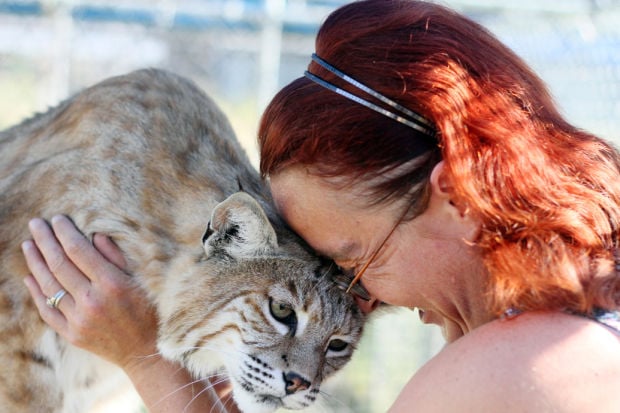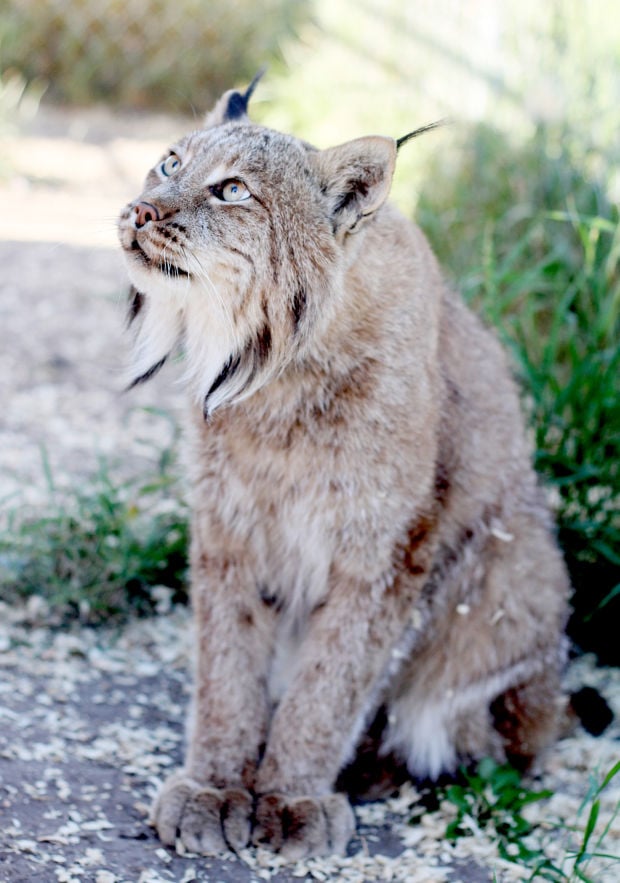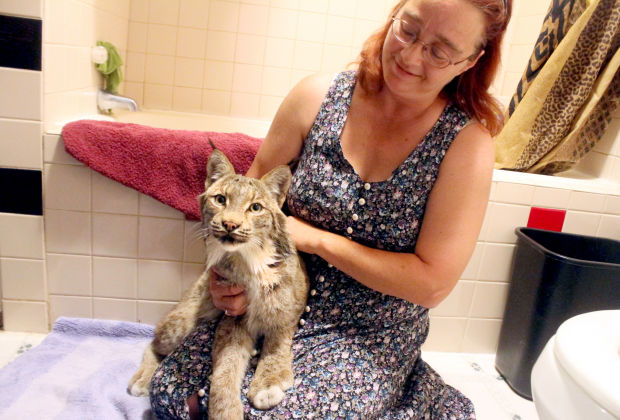STEVENSVILLE – When Deborah Roe turns off the lights in her
bathroom, all she can see are the green glowing eyes of a full-grown
female Canada lynx staring back at her.
Deborah and her husband Gerald aren’t typical pet owners. When they feed their cats, they use whole chickens, rabbits or giant cuts of salmon. Sometimes, they feed them deer or elk steaks donated by local hunters.
The Roes have three bobcats and three Canada lynx on their property north of Stevensville, and all six are beloved family pets.
Bella, a three-year-old female lynx, lives in the house and is potty-trained.
“Yep, she climbs right up on the toilet,” Deborah said. “We call this place Lynxville, Montana.”
There’s Billy, a neutered male bobcat who purrs loudly when Deborah enters his cage and rubs his head on her face affectionately. Leo the bobcat has been a photography model for calenders and movies. Lily is the real star – she was featured stalking a rabbit through deep snow in a National Geographic film clip for a program called NatGeoWild. (Spoiler alert: It wasn’t a good day for the rabbit.)
“That was actually filmed in our backyard in Wisconsin,” Deborah said. “Lily loves the camera.”
The other two Canada lynx, Nanook and Nikki, might not be alive today if Deborah hadn’t found them.
“I got them off a fur farmer in North Dakota,” she said. “I bought them because he was going to pelt them out, so I had to pay pelt prices. He had them for four years. The other one, Bella, I got her from the same guy when she was a 13-day-old kitten. And now she’s the love of my life.“
Canada lynx have huge paws which make them adept at traveling over snow and hunting their favorite prey, snowshoe hares. They also have distinctive black tufts at the ends of their ears. Bobcats have beautiful spots on their fur, which also makes them a target for trappers and taxidermists.
Bobcats and lynx are in the same genus: The scientific name for bobcats is lynx rufus, while Canada lynx are classified as lynx canadensis. There are thirteen accepted subspecies of bobcats, and their range stretches from southern Canada to Mexico. There are three subspecies of Canada lynx, and they range from Alaska to the northern U.S. In 2000, the Canada lynx was listed as a threatened species in 16 U.S. states, and there is a a reintroduction effort underway in Colorado, where the species went extinct in the 1970s.
“They eat snowshoe hare almost exclusively in the wild,” Gerald explained. “So their population goes way down if there isn’t enough snowshoe hare to eat, because they stop reproducing.”
According to Mike Lee, a game warden and commercial wildlife permit manager for Montana Fish, Wildlife and Parks Enforcement, there are currently 15 licensed fur farms in Montana. The licenses are required for anyone who wants to possess, rear in captivity, buy or sell any fur-bearing animal in the state. The licenses also require the animals must be kept in enclosures sufficient to prevent escape into the wild.
“These are my babies,” Deborah exclaims passionately, stroking Billy between his ears and letting him lick her arm. “We are absolutely not raising them for fur. I have never ever pelted an animal of any kind. On the rare occasion that we do lose a cat, I bury them in the backyard with a marker.”
Roe also said that she has strict guidelines for selling kittens.
“Nobody in their right mind would sell an animal to just anybody who walks through the door,” she explains. “These animals are strictly controlled in the majority of states. Before somebody even thinks about it, you need to know state and county laws and what permits are needed. Before I will let one of my animals go, we need an interview. We don’t allow anybody that has small children. They must own their own home, and they have got to have provable prior experience with owning these animals. And whenever possible, they need references. I will talk to local veterinarians and see how they treat their other animals.”
Deborah said she and her husband just wanted to get the fur farm license in case they ever decide to breed.
“We’re not breeding and selling cats like people breed and sell dogs,” she said. “We don’t have immediate plans to breed, but we may end up wanting to breed a litter. It’s not like my girls are just going to be pumping out kittens.“
The animals on the Roes’ property are housed inside separate pens made of woven kennel fencing. Gerald gets upset when he hears about the perception that his cats might somehow get loose and spread disease to wild bobcats or lynx.
“I would be more worried about all the feral cats spreading disease,” he said. “Ours are healthy and they are inside their pens. They’re not going anywhere.”
Deborah said her husband bought her the first bobcat, Billy, several years ago to see if raising big cats was something she wanted to do.
“Two weeks later I was hooked for life,” she said. “It took an awful lot of research in six different states. We visited 40 different zoos and talked with a lot of people, especially animal trainers. There are a lot of bigger outfits in the country that keep track of this stuff, like the U.S. Zoological Association and the Feline Conservation Federation, which is trying to keep these cats in good shape and properly cared for and regulated. Bella was in the FCF journal.”
“We don’t drag them all over the place, and we don’t let people come and be with them,” she said. “They are our pets, it’s no big deal. There was another newspaper article about us, and they made it sound like I was just going to breed exotic cats and send them out the door. That is so wrong. I have worked with animal rescues and the Bureau of Land Management. I have been an animal person my entire life. I even worked with a parrot rescue. It would be nice if all these cats could live in the wild, but these cats were not born in the wild and would not survive in the wild, so we do all we can to make these cats happy and comfortable. That is my entire purpose. Everything I do I do for them.”
The cats are drowsy during the heat of the day, but perk up when the sun goes down.
“Once they’ve fed they go into stalk mode,” Deborah said. “They are really busy watching and listening to what’s going on at night. They like to watch horses, and my chickens and ducks. We have a skunk that wanders through here, and he must be pretty brave.”
Overall, Deborah said she wants to be an advocate for the animals.
“I want people to realize they are cuddly,” she said. “They are my babies, and I love my babies.”
To watch the National Geographic video of Lily hunting a rabbit in winter, visit online at www.youtube.com/watch?vXV-c9SXlSJY.
source
Deborah and her husband Gerald aren’t typical pet owners. When they feed their cats, they use whole chickens, rabbits or giant cuts of salmon. Sometimes, they feed them deer or elk steaks donated by local hunters.
The Roes have three bobcats and three Canada lynx on their property north of Stevensville, and all six are beloved family pets.
Bella, a three-year-old female lynx, lives in the house and is potty-trained.
“Yep, she climbs right up on the toilet,” Deborah said. “We call this place Lynxville, Montana.”
There’s Billy, a neutered male bobcat who purrs loudly when Deborah enters his cage and rubs his head on her face affectionately. Leo the bobcat has been a photography model for calenders and movies. Lily is the real star – she was featured stalking a rabbit through deep snow in a National Geographic film clip for a program called NatGeoWild. (Spoiler alert: It wasn’t a good day for the rabbit.)
“That was actually filmed in our backyard in Wisconsin,” Deborah said. “Lily loves the camera.”
The other two Canada lynx, Nanook and Nikki, might not be alive today if Deborah hadn’t found them.
“I got them off a fur farmer in North Dakota,” she said. “I bought them because he was going to pelt them out, so I had to pay pelt prices. He had them for four years. The other one, Bella, I got her from the same guy when she was a 13-day-old kitten. And now she’s the love of my life.“
*****
All six of the animals were born in captivity.
The Roes have raised dozens of cats over the years, and many of the
animals they raised are now in zoos in Wisconsin, where they used to
live.Canada lynx have huge paws which make them adept at traveling over snow and hunting their favorite prey, snowshoe hares. They also have distinctive black tufts at the ends of their ears. Bobcats have beautiful spots on their fur, which also makes them a target for trappers and taxidermists.
Bobcats and lynx are in the same genus: The scientific name for bobcats is lynx rufus, while Canada lynx are classified as lynx canadensis. There are thirteen accepted subspecies of bobcats, and their range stretches from southern Canada to Mexico. There are three subspecies of Canada lynx, and they range from Alaska to the northern U.S. In 2000, the Canada lynx was listed as a threatened species in 16 U.S. states, and there is a a reintroduction effort underway in Colorado, where the species went extinct in the 1970s.
“They eat snowshoe hare almost exclusively in the wild,” Gerald explained. “So their population goes way down if there isn’t enough snowshoe hare to eat, because they stop reproducing.”
According to Mike Lee, a game warden and commercial wildlife permit manager for Montana Fish, Wildlife and Parks Enforcement, there are currently 15 licensed fur farms in Montana. The licenses are required for anyone who wants to possess, rear in captivity, buy or sell any fur-bearing animal in the state. The licenses also require the animals must be kept in enclosures sufficient to prevent escape into the wild.
*****
The Roes recently applied for a fur farm application from FWP,
but they both say the name of the application is a misnomer because it
couldn’t be further from their actual desire. Their goal is just to be
licensed in case they want to sell kittens someday. They have plans to
build a larger enclosed habitat for the cats than what they have now.“These are my babies,” Deborah exclaims passionately, stroking Billy between his ears and letting him lick her arm. “We are absolutely not raising them for fur. I have never ever pelted an animal of any kind. On the rare occasion that we do lose a cat, I bury them in the backyard with a marker.”
Roe also said that she has strict guidelines for selling kittens.
“Nobody in their right mind would sell an animal to just anybody who walks through the door,” she explains. “These animals are strictly controlled in the majority of states. Before somebody even thinks about it, you need to know state and county laws and what permits are needed. Before I will let one of my animals go, we need an interview. We don’t allow anybody that has small children. They must own their own home, and they have got to have provable prior experience with owning these animals. And whenever possible, they need references. I will talk to local veterinarians and see how they treat their other animals.”
Deborah said she and her husband just wanted to get the fur farm license in case they ever decide to breed.
“We’re not breeding and selling cats like people breed and sell dogs,” she said. “We don’t have immediate plans to breed, but we may end up wanting to breed a litter. It’s not like my girls are just going to be pumping out kittens.“
The animals on the Roes’ property are housed inside separate pens made of woven kennel fencing. Gerald gets upset when he hears about the perception that his cats might somehow get loose and spread disease to wild bobcats or lynx.
“I would be more worried about all the feral cats spreading disease,” he said. “Ours are healthy and they are inside their pens. They’re not going anywhere.”
Deborah said her husband bought her the first bobcat, Billy, several years ago to see if raising big cats was something she wanted to do.
“Two weeks later I was hooked for life,” she said. “It took an awful lot of research in six different states. We visited 40 different zoos and talked with a lot of people, especially animal trainers. There are a lot of bigger outfits in the country that keep track of this stuff, like the U.S. Zoological Association and the Feline Conservation Federation, which is trying to keep these cats in good shape and properly cared for and regulated. Bella was in the FCF journal.”
*****
Roe said there are a lot of misperceptions among the general public about how people with large cats treat the animals.“We don’t drag them all over the place, and we don’t let people come and be with them,” she said. “They are our pets, it’s no big deal. There was another newspaper article about us, and they made it sound like I was just going to breed exotic cats and send them out the door. That is so wrong. I have worked with animal rescues and the Bureau of Land Management. I have been an animal person my entire life. I even worked with a parrot rescue. It would be nice if all these cats could live in the wild, but these cats were not born in the wild and would not survive in the wild, so we do all we can to make these cats happy and comfortable. That is my entire purpose. Everything I do I do for them.”
The cats are drowsy during the heat of the day, but perk up when the sun goes down.
“Once they’ve fed they go into stalk mode,” Deborah said. “They are really busy watching and listening to what’s going on at night. They like to watch horses, and my chickens and ducks. We have a skunk that wanders through here, and he must be pretty brave.”
Overall, Deborah said she wants to be an advocate for the animals.
“I want people to realize they are cuddly,” she said. “They are my babies, and I love my babies.”
To watch the National Geographic video of Lily hunting a rabbit in winter, visit online at www.youtube.com/watch?vXV-c9SXlSJY.
source


